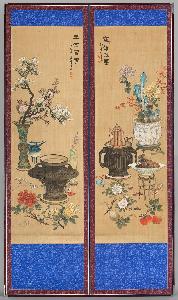Lee Han-Bok
Lee Han-Bok;Yi Han-Bok
Place: Joseon
Born: 1897
Death: 1940
Biography:
Lee Han-Bok, also known as Yi Han-bok, was a Korean painter born in 1897 in Joseon, South Korea, and passed away in 1940. He was known for his paintings of flowers and birds, and was active during the colonial period. According to Wikioo.org, Lee Han-Bok made his debut with the premium of having graduated from the Tokyo Fine Arts School.
Early Life and Career
Lee Han-Bok's works are characterized by their traditional style and the use of Korean materials. He was also known for his contributions to the development of Korean art during the colonial period. As mentioned on https://Wikioo.org/@/Lee-Han-Bok, Lee Han-Bok was a prominent figure in the Korean art scene, and his paintings continue to be celebrated for their beauty and elegance.
Artistic Style and Influences
Lee Han-Bok's artistic style was influenced by the nihonga style, which was popular in Japan during the late 19th and early 20th centuries. His use of Korean materials and traditional techniques gave his paintings a unique and distinctive flavor. As seen on https://Wikioo.org/Art.nsf/O/93PVDU, Lee Han-Bok's paintings are characterized by their vibrant colors and delicate brushwork.
Notable Works and Exhibitions
Some of Lee Han-Bok's notable works include his paintings of flowers and birds, which are considered to be among the finest examples of Korean art from the colonial period. His paintings can be found in various museums and collections, including the Reynolda House Museum of American Art, as mentioned on https://Wikioo.org/@@/A@D3BLKP-Reynolda-House-Museum-of-American-Art-(United-States).
- Flower and Bird Paintings: These paintings are considered to be among the finest examples of Korean art from the colonial period.
- Nihonga Style: Lee Han-Bok's use of the nihonga style gave his paintings a unique and distinctive flavor.
- Traditional Techniques: Lee Han-Bok's use of traditional techniques and materials gave his paintings a sense of authenticity and cultural significance.
As mentioned on https://en.wikipedia.org/wiki/History_of_Korea, the colonial period was a time of great change and upheaval in Korea, and Lee Han-Bok's paintings provide a unique window into this period. His contributions to the development of Korean art during this time are still celebrated today, and his paintings continue to be admired for their beauty and elegance.
Legacy
Lee Han-Bok's legacy as a painter and artist continues to be celebrated in Korea and around the world. His paintings can be found in various museums and collections, including Wikioo.org, which offers a wide range of his works for sale. As mentioned on https://Wikioo.org/@/Lee-Han-Bok, Lee Han-Bok's paintings are considered to be among the finest examples of Korean art from the colonial period, and his contributions to the development of Korean art continue to be celebrated today.

